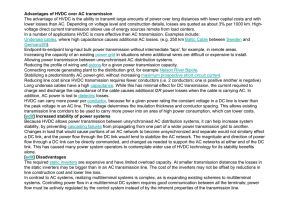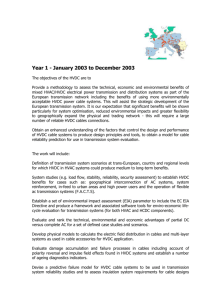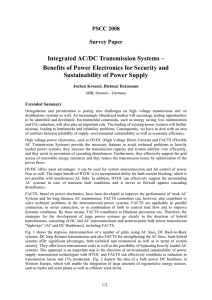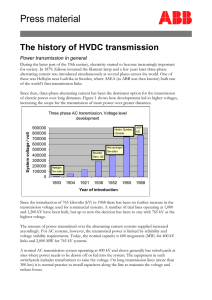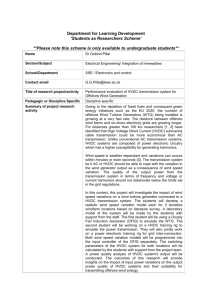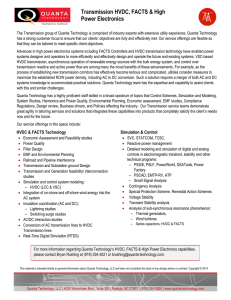High Voltage Direct Current Transmission
advertisement
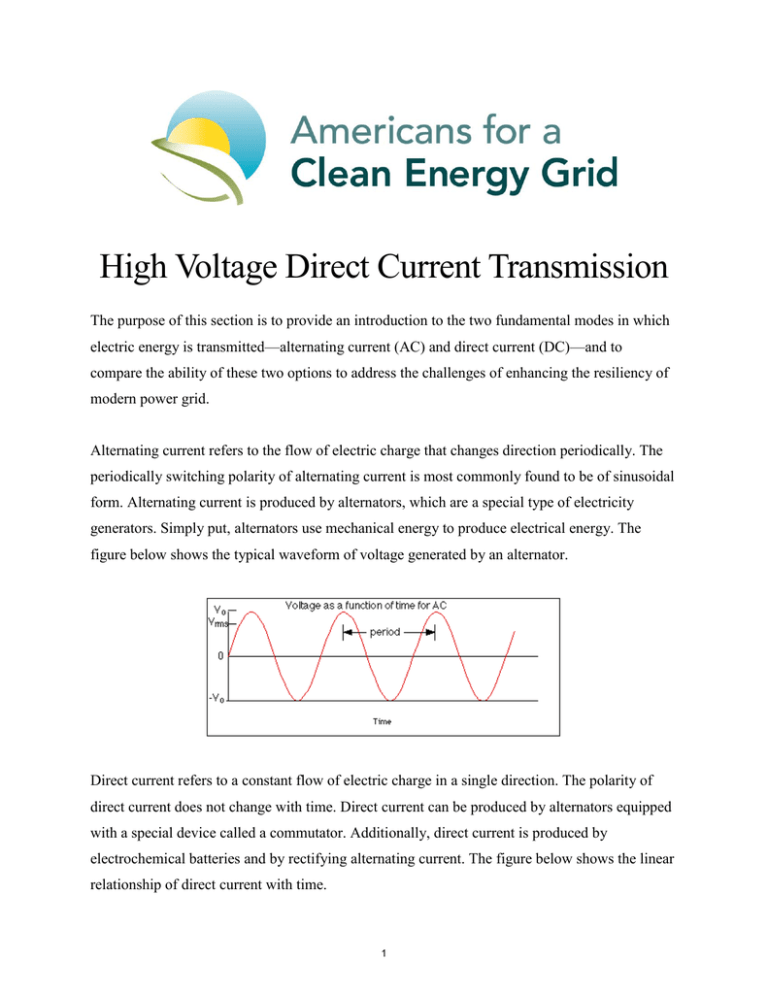
High Voltage Direct Current Transmission The purpose of this section is to provide an introduction to the two fundamental modes in which electric energy is transmitted—alternating current (AC) and direct current (DC)—and to compare the ability of these two options to address the challenges of enhancing the resiliency of modern power grid. Alternating current refers to the flow of electric charge that changes direction periodically. The periodically switching polarity of alternating current is most commonly found to be of sinusoidal form. Alternating current is produced by alternators, which are a special type of electricity generators. Simply put, alternators use mechanical energy to produce electrical energy. The figure below shows the typical waveform of voltage generated by an alternator. Direct current refers to a constant flow of electric charge in a single direction. The polarity of direct current does not change with time. Direct current can be produced by alternators equipped with a special device called a commutator. Additionally, direct current is produced by electrochemical batteries and by rectifying alternating current. The figure below shows the linear relationship of direct current with time. 1 There was a time in history when it was uncertain which current would be utilized for the United States and other electricity systems. This battle of alternating versus direct current started between Thomas Edison and George Westinghouse in the late nineteenth century [5]. Thomas Edison wanted electricity to be transmitted as direct current, while George Westinghouse, relying on the patents of Nikola Tesla, favored alternating current [5]. Electric power was at first transmitted predominantly as direct current (DC), but, back then, it was impossible to transmit direct current over long distances without significant power losses. This, as it turned out, was one key restriction that stopped direct current from becoming the primary mode of power transmission [5]. As the electric grid network expanded, transformers—which only work for alternating current (AC)—made it easy to step up and step down the voltage of alternating current for long distance transmission [5]. Introduction of robust induction motors and superior synchronous generators also increased the demand for alternating current. High voltage alternating current (HVAC) soon became the preferred mode of electricity transmission over long distances. Over the next few decades, electric power was almost entirely transmitted as high voltage alternating current over long distances. Although George Westinghouse won the first battle of currents in the late nineteenth century, the debate of direct versus alternating current has been rekindled due to the development of new technology that strongly favors direct current. In 1954, ABB built the first high voltage direct current (HVDC) transmission line between Gotland Island and the Swedish mainland [2]. This HVDC transmission line carried 20 megawatts (MW) of electric power at -100 kilovolts (kV) for 60 miles through submarine cables [2]. Ever since, the number of HVDC transmission lines has 2 been steadily increasing all over the world because of the development of efficient and cheaper DC/DC converters, thyristors, insulated gate bipolar transistors, and high voltage DC circuit breakers. Thyristors and insulated gate bipolar transistors are solid state semiconductor devices required for conversion between direct and alternating currents, whereas high voltage DC circuit breakers are necessary for controlling high voltage direct currents, such as shutting down the transmission in case of an emergency. Beyond the recent successes and efficiencies of HVDC, there has arisen a need to transport energy from distant resources to metropolitan load centers, especially renewable resources such as sun and wind. HVAC and HVDC transmission lines have their own advantages and disadvantages. For HVAC power transmission, the voltage can be stepped up to 765 kV with relative ease [10]. 765 kV is the maximum voltage for HVAC transmission in the United States. For voltages beyond it, power dissipation through electric losses becomes too significant to be worthwhile [10]. The sum of electric losses for an HVAC transmission line equals the total heat dissipated in that HVAC transmission line. This heat dissipation is directly proportional to the square of the alternating current times the line resistance, and this is why HVAC transmission lines carry low currents at high voltages to minimize power losses. 𝑃𝑜𝑤𝑒𝑟 𝑙𝑜𝑠𝑠𝑒𝑠 = 𝑐𝑢𝑟𝑟𝑒𝑛𝑡 2 ∗ 𝑟𝑒𝑠𝑖𝑠𝑡𝑎𝑛𝑐𝑒 Because of this dynamic, the challenge with HVAC arises during periods of peak demand when the current is flowing at its strongest, meaning that heat dissipation is also greatest and significant electric losses are suffered. This, when power is most valuable and outages most costly. In addition, the low current in HVAC transmission lines restricts their power carrying capacity, which equals the product of current and voltage across a transmission line: 𝑃𝑜𝑤𝑒𝑟 = 𝑣𝑜𝑙𝑡𝑎𝑔𝑒 ∗ 𝑐𝑢𝑟𝑟𝑒𝑛𝑡 HVAC transmission lines can be made thicker to carry greater current, but the diameter of HVAC transmission lines is restricted by the ‘skin effect’ [13]. The skin effect is the tendency of alternating current to flow along the outer surface of conductors because of the presence of eddy 3 currents in the middle of the conductor [13]. Eddy currents are induced by changing magnetic fields inside a conductor carrying alternating current, and can cause repulsion, attraction, drag and heating effects in a conductor, while not contributing anything useful [9]. For HVAC cables thicker than an inch at 60 Hz (the typical frequency of alternating current in the US), the skin effect becomes significant and restricts alternating current from distributing itself evenly across the cross-sectional area of the cable [13]. Most of the alternating current flows near the circumference of thick cables. Therefore, HVAC transmission lines cannot be made thicker to increase their power carrying capacity. Eddy currents and the resulting skin effect are only present for alternating currents. HVDC transmission lines, on the other hand, can be made thicker to carry more power. Beyond the lack of skin effect, HVDC transmission lines offer a number of advantages over HVAC transmission lines such as greater power carrying capacity, the ability to connect asynchronous AC electric systems, precise control of electric power flow, and longer underground and undersea transmission lines. Typically, overall losses in HVDC transmission are 30-50% less than HVAC transmission [11]. Although HVDC incurs power losses during the conversion process from AC to DC, the line losses in HVDC cable are smaller than HVAC cables. When used over long distances, lower cable losses compensate for higher conversion losses of HVDC transmission. Typically for distances greater than 180 miles, overall losses in HVDC transmission are smaller than in HVAC transmission [1]. The graph below depicts the overall losses against transmission distance for HVAC and HVDC systems.[1] 4 As mentioned before, HVDC transmission lines can carry more current—up to 40% more—than HVAC transmission lines of the same size [11]. This ability to carry higher currents while suffering smaller power losses results in significantly higher power carrying capacity of HVDC transmission lines, which in turn reduces the land footprint for HVDC transmission networks, reducing social, political, and not-in-my-backyard resistance towards transmission line siting. Another key benefit of HVDC transmission lines is the ability to precisely control power flow. AC power acts like flowing water, taking the path of least resistance and resulting in unequal distribution of power across a system along with stability issues. In an HVDC system, the power flow can be precisely controlled by the operator to avoid grid stability issues resulting from unequal power flow. The most notable advantage of HVDC transmission lines is their ability to transfer power underground and undersea over long distances, which can open the door for intercontinental electric power trade and unlock electricity production from wind energy. Restricted by significant time delays resulting from capacitance, HVAC underground transmission lines can only be used for approximately 40 miles [2]. Time delays resulting from capacitance are considerably smaller for HVDC transmission lines; therefore, HVDC transmission lines are ideal for long-distance underground and undersea power transmission, but are potentially costprohibitive at shorter distances. Currently, Siemens Energy and Prysmian are working on a 260mile, 2200 MW, 600 kV submarine HVDC transmission line connecting Scotland and England [12]. The power losses for this 260 miles long HVDC transmission line are estimated to be as low as 3% (including converter and cable losses) [12]. Undersea power transmission also allows electricity generated by offshore wind plants to be integrated into national grids without considerable losses. Because HVDC transmission lines are not restricted by the 40-mile range of HVAC, offshore wind plants can be installed further out in the seas where relatively higher wind speeds cause wind turbine blades to rotate faster, producing more electricity. Like any technology, HVDC transmission has disadvantages and restrictions. Power plants generate alternating current, which must be converted to direct current before transmission over HVDC lines. Converting high voltage alternating current to direct current requires the use of sophisticated and very expensive equipment such as thyristors, insulated gate bipolar transistors 5 (IGBTs), high voltage DC breakers, and harmonic filters. As can be seen in the graphic below, an HVDC substation can cost on the order of eleven times more than an HVAC substation. [14] Along with higher capital costs, HVDC terminals have other disadvantages, such as their inability to withstand overload and higher operational costs. Unlike an HVAC system, a typical HVDC system cannot exceed its rated load even for a short time period. This means that HVDC systems are incapable of withstanding overload conditions and pose a greater risk to system stability under overload conditions. Additionally, the use of sophisticated and maintenanceintensive equipment such as thyristors, insulated gate bipolar transistors, high voltage DC breakers, and harmonic filters make the cost of operating an HVDC terminal greater than the cost of operating an HVAC substation. The operating cost of an HVDC terminal is further increased by the complex cooling systems required to keep the converting equipment at their critical operating temperature. Although the cost of setting up and operating a HVDC terminal is higher than that of an HVAC substation, the cost of HVDC cable is much lower than the cost of HVAC cable. What this means is that beyond a specific distance, it is actually overall cheaper to transmit power over HVDC lines. The graph below depicts this logic. 6 [1] Because HVDC cables are considerably less expensive than HVAC cables, the total cost of a HVDC transmission project (HVAC terminal + HVDC cable) increases more slowly with distance than the total cost of a HVAC transmission project (HVAC substation + HVAC cable). After a critical distance (approximately 500 miles in most cases), the total cost of a HVDC transmission project is less than a HVAC transmission project [1]. This fact makes HVDC an ideal choice for long distance (over 500 miles) in addition to underground and undersea power transmission. One final point worth noting is that HVDC transmission lines do offer the ability to connect asynchronous electric systems. Two alternating current electric systems are considered asynchronous if they are operating at different frequencies. It was nearly impossible to connect asynchronous electric systems using HVAC transmission lines until recent advancements in variable frequency transformer technology. Although HVDC transmission lines can be used to connect asynchronous systems, variable frequency transformers offer additional benefits that HVDC wires cannot offer. Variable frequency transformers offer bump-less startup, low harmonics, low impact on adjacent generators and familiarity to typical power engineers, which make variable frequency transformers the primary choice for connecting asynchronous systems [4]. Connecting asynchronous grids allows different grid systems to trade electricity and meet their respective consumer power demands. HVDC transmission lines are currently used to 7 connect the Eastern and Western US grids and the Quebec AC grid with the Eastern US grid. However, the additional benefits might make variable frequency transformers the preferred method of connecting asynchronous power grids. The demand for HVDC converter stations was estimated to be $1.1 billion in 2006, $8.3 billion in 2012 and is predicted to increase up to $89 billion by 2020 [7]. This growth in the HVDC industry is being fueled by technological developments such as cheaper high voltage DC breakers and substantial investments in HVDC research by governments and private companies. The increasing trend in the growth of the HVDC industry suggests that HVDC transmission lines are slowly and steadily becoming the preferred mode of long distance electric power transmission. Companies like Siemens Energy and ABB are at the forefront of HVDC transmission industry and are currently working on numerous HVDC projects across the globe. The United States, Brazil, Germany, and China have undertaken a significant number of HVDC transmission projects. Currently, China is the largest stakeholder in the global HVDC industry and is further partnering up with ABB on numerous long distance HVDC transmission projects. The ability to carry power over long distances without significant power losses suggests that HVDC transmission lines could slowly become the primary choice for long distance power transmission in the United States. As more solar power projects are constructed in the southwest U.S. and wind power projects in the middle corridor of the U.S., more HVDC transmission projects may be commissioned to transmit the energy to the rest of the country. With further advancements in HVDC technology, the 500-mile financial feasibility limit would most likely decrease, and more midrange HVDC projects would be constructed. Until that time, HVAC cables would be used for short distance transmission and the entire distribution network. In summary, based on current trends and technologies, the United States should see an increasing number of HVDC transmission projects going forward, and should be better off for it. 8 References: [1] ABB, Economic and Environmental Advantages of HVDC. Accessed on May 29, 2014. Retrieved from http://new.abb.com/systems/hvdc/why-hvdc/economic-and-environmental-advantages [2] ABB, The Gotland HVDC link. Accessed on May 30, 2014. Retrieved from http://new.abb.com/ systems /hvdc/references/the-gotland-hvdc-link [3] Electrical Engineering Portal, Advantages of HVDC over HVAC transmission. Accessed on May 29, 2014. Retrieved from http://electrical-engineering-portal.com/advantages-of-hvdc-over-hvactransmission [4] GE Energy, Variable Frequency Transformers. Accessed on June 9, 2014. Retrieved from https://www.gedigitalenergy.com/products/brochures/powerD_vtf/vft_brochure.pdf [5] Gilbert King, Edison vs. Westinghouse: A shocking rivalry. Accessed on June 10, 2014. Retrieved from http://www.smithsonianmag.com/history/edison-vs-westinghouse-a-shocking-rivalry102146036/ [6] J.R Lucas, High voltage engineering. Accessed on May 30, 2014. Retrieved from http://www.dee. hcmut.edu.vn/vn/bomon/bmhethong/tailieu/tienganh/High%20Voltage%20Engineering.pdf [7] Kelvin Ross, HVDC converter station marlet set to hit $89 billion. Accessed on May 30, 2014. Retrieved from http://www.powerengineeringint.com/articles/2013/09/hvdc-converter-stationmarket-value-set-to-hit-89bn.html [8] National Grid, Fact sheet HVDC electricity. Accessed on May 29, 2014. Retrieved from http://www.nationalgrid.com/NR/rdonlyres/5B1C39CD-FE5D-4D18-8402A75EC4984962/50189/20100621_HVDC_detailed_Factsheet_FINAL.pdf [9] NDT Resource Center, Eddy Current. Accessed on June 9, 2014. Retrieved from http://www.ndted.org/EducationResources/HighSchool/Electricity/eddycurrents.htm [10] Rodger Faulkner, AC vs DC power lines and the electrical grid. Accessed on May 28, 2014. Retrieved from http://theenergycollective.com/rogerrethinker/204396/ac-versus-dc-powerlines [11] Siemens Energy, Fact Sheet HVDC. Accessed on May 28, 2014. Retrieved from http://www.siemens.com/press/pool/de/feature/2013/energy/2013-08-x-win/factsheet-hvdce.pdf [12] Siemens Energy, Siemens to increase power transmission between England and Scotland. Accessed on May 29, 2014. Retrieved from http://www.siemens.com/press/en/pressrelease/?press=/en/ pressrelease/2012/energy/power-transmission/ept201202029.htm [13] University of Colorado, The Skin Effect. Accessed on June 9, 2014. Retrieved from http://ecee.colorado.edu/~ecen3400/C hapter%2020%20-%20The%20Skin%20Effect.pdf [14] Western Electricity Coordinating Council, Transmission and substation capital cost. Accessed on June 10, 2014. Retrieved from https://www.wecc.biz/Lists/Calendar/Attachments/5892 /140212_WECC_TxCapitalCostRecommendations_Final.pdf 9
